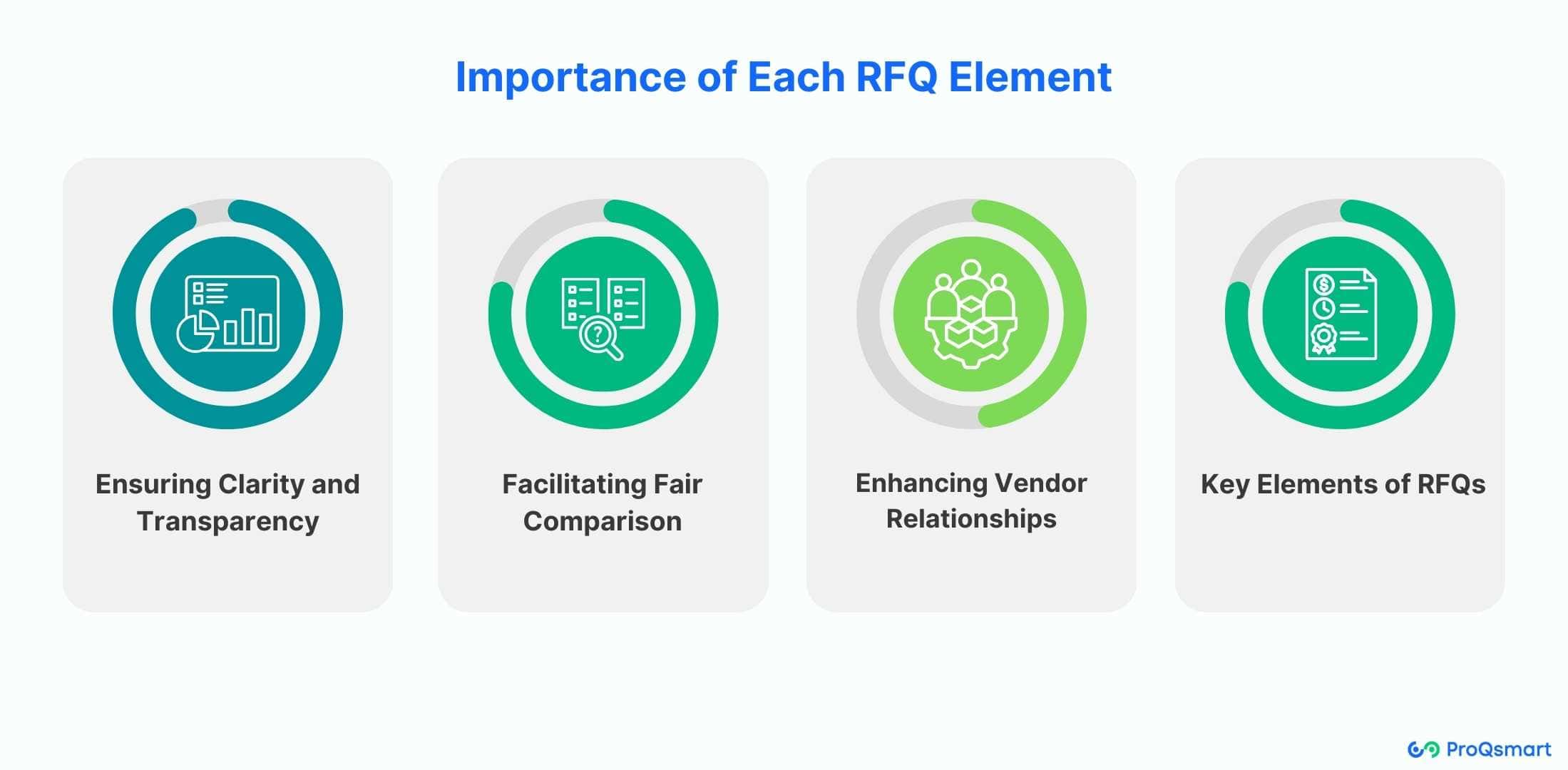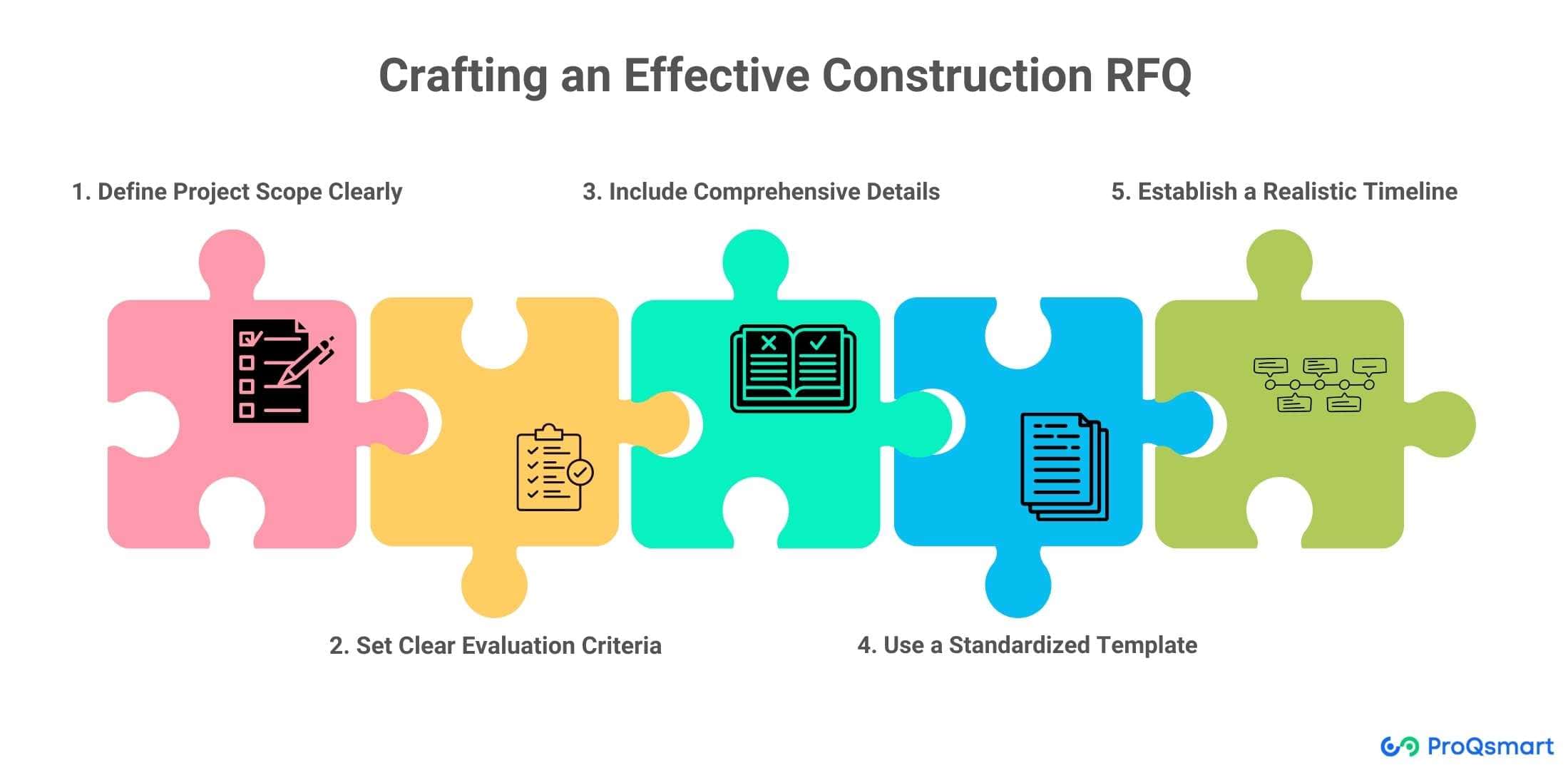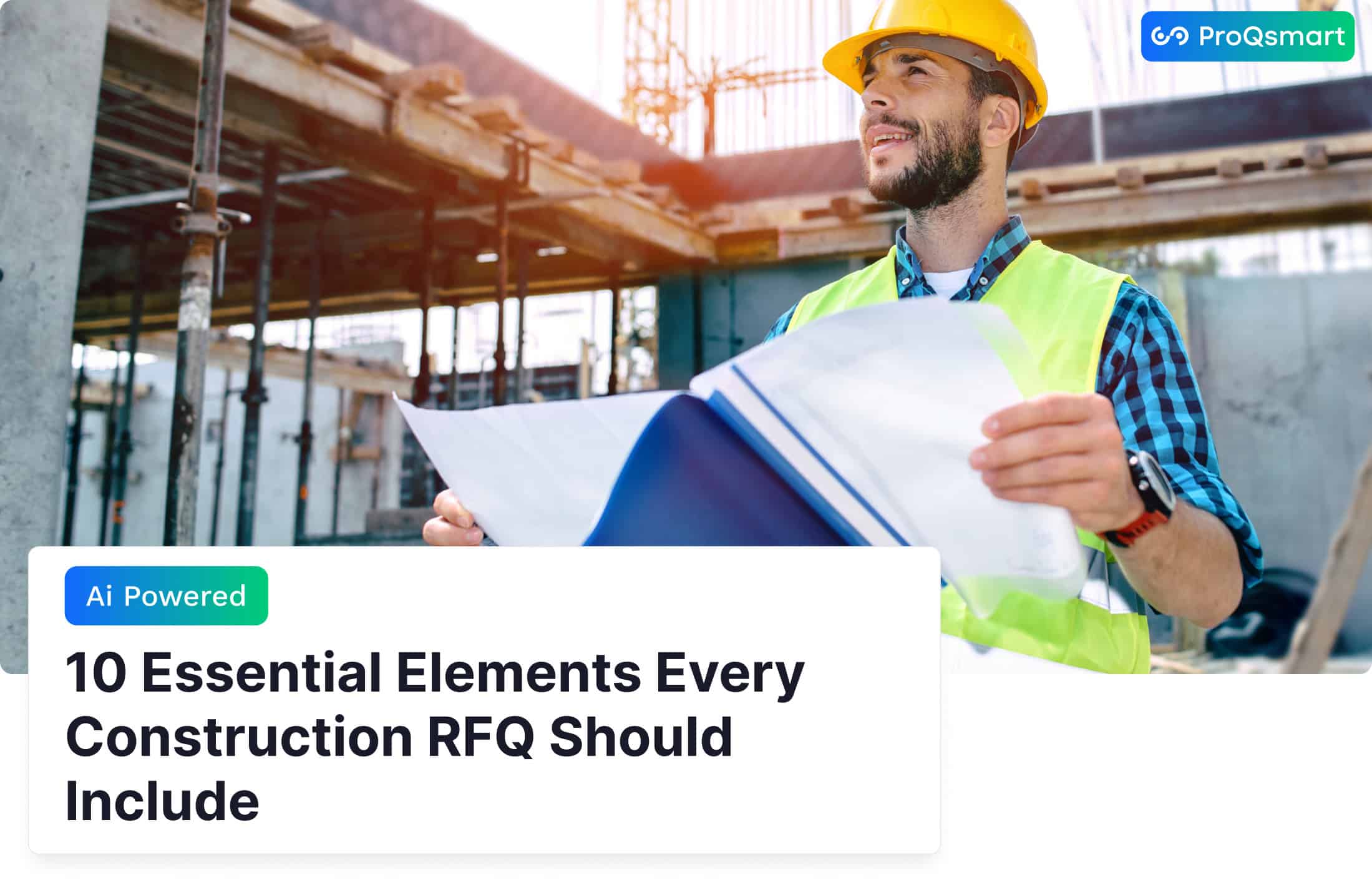Ever wondered what makes a construction RFQ effective? A Request for Quotation is essentially a project’s opening act. Nail down key elements: scope, timeline, and budget. Every single piece makes a difference. Leave one out, and chaos may reign.
Think of an RFQ as the blueprint. Without it, you’re lost. Are there best practices? Write it clean and straight. Lay off the jargon. Make it simple.
Examples of well-done RFQs are gold. They lead you; they show you the way. Simply being knowledgeable does not create credibility in procurement. It demands clarity and understanding.
This post goes deep, showing you what you need to know. You’ll walk away ready to tackle any RFQ challenge. Let’s get in there and do this. Ready to actually get your act together?
Key Takeaways
- An RFQ, or Request for Quotation, is important in construction. It solicits price quotes from suppliers and contractors to ensure competitive pricing and value.
- What’s included in a construction RFQ? It may include details like project specifications, timelines, and required materials. It also lists actual qualifications or certifications that bidders must have.
- Every aspect of an RFQ is important for getting accurate and thorough bids. Leave any part out, and it may lead to project delays or budget overruns.
- To write a good RFQ, explain what your project requires. Document everything exactly, and ensure you’ve answered most of the questions a bidder will ask.
- When missing key elements from an RFQ, you risk incomplete bids. This misalignment between project requirements and deliverables raises project risks.
- Adhering to best practices for RFQ timelines allows bidders to adequately prepare a response. This method encourages a more fair and competitive bidding experience.
Understanding RFQ in Construction
The RFQ, or Request for Qualifications, is an integral part of the construction procurement process. Think of it like a formal handshake with potential vendors. You’re actively looking for pricing and other important details to help you make an informed decision.
This document allows you to compare costs and specifications very easily. It lets you get the best value possible for your project. Using RFQs can streamline the procurement process and make it easier and less stressful. It’s about ensuring that you choose the right partners in your building efforts.
What is an RFQ?

An RFQ serves a very specific purpose in the construction procurement process. We collect detailed information on how much potential vendors charge and how qualified they are. This occurs before we launch any formal bidding.
Consider an RFQ your way to say, “Show me what you’ve got,” to the vendors. Key components in an RFQ include the scope of work, timelines, and specific materials or services needed.
It’s different from a Request for Proposal (RFP) that centers on the how of executing a project. Especially in RFQs, accuracy matters; a mistake can result in choosing the wrong vendor, wasting time and money. Contractors submit SOQs in response to RFQs, which helps you weed out which applicants are qualified enough to bid on your project.
When to Use RFQ in Projects
There are certain times when an RFQ is most useful. Use an RFQ if your project has set, defined needs. It’s a good option if you’re looking at cost and qualifications.
It’s most useful when you have a very good idea of what your project needs. Making it a priority for your budget also makes it a top contender. Businesses should use an RFQ when they want to verify qualifications first.
This approach allows them to explore proposal details afterward. Before you send out an RFQ, have a clear understanding of your project. This clarity helps in setting the right expectations with potential vendors.
Budget considerations play a significant role in your decision-making. Understanding your financial limits can help you decide whether you need to choose an RFQ to stay within budget.
RFQ vs RFP Differences

Focus Areas | RFQ | RFP |
Main Concern | Qualifications and Cost | Detailed Proposal and Approach |
Best Suited For | Clear and Defined Projects | Complex Projects Needing Creative Solutions |
Project Complexity | Simplified, straightforward tasks | Projects requiring innovation and detailed plans |
Choosing between an RFQ and an RFP can depend heavily on the project’s complexity. For projects where you have unclear or missing specs, an RFQ can clarify those details.
An RFP is better utilized for complex projects that require detailed proposals. If you don’t select the correct document type, you risk miscommunication, delayed timelines, and even loss of money.
An RFQ is often the first step in the process. After that, it may be followed by an RFP and interviews with the shortlisted firms. Generally, you are expected to focus on qualifications 75% of the time and fee proposals the other 25% of the time.
Essential Elements of a Construction RFQ

Crafting a construction RFQ entails mindful consideration of a few key elements that are crucial for effective RFQ management. These elements underpin a successful procurement process, as a well-crafted RFQ not only helps you communicate clearly but also streamlines the bidding process with prospective suppliers, ensuring you receive competitive bids for your project.
Cover Page and Table of Contents
Include the project name, buyer’s contact information, RFQ number, bidder instructions, and timeline. This sets the stage by giving the reader a clear snapshot of the RFQ.
A well-organized table of contents enhances navigation and helps vendors easily locate specific sections. It reflects the professionalism of the document and eases the review process.
These components add to the professional appearance of the document. They establish an authoritative tone that communicates seriousness and attention to detail from the onset.
Company Overview and Background
Keep it brief, but let us know what we need to know about a quick back-story, your mission, and your main capabilities. It gives vendors context and gives you credibility.
This helps vendors understand the buyer’s context and align their proposals with organizational goals. Emphasize the experience that will draw like-minded qualified vendors to your business.
Use straightforward language and consider visuals or infographics to make your company information visually appealing and easier to digest.
Detailed Product Descriptions
Comprehensive product specifications, including technical requirements, quantities, and delivery needs, are crucial. They help vendors write accurate quotes and avoid vagueness.
Clear product descriptions ensure vendors fully understand your needs, leading to more accurate and competitive bids. Use diagrams when possible to aid the reader’s brain even further.
Including a BOQ (Bill of Quantities) can make it easier for contractors to bid and plan.
Onboarding and Implementation Plan
Outlining onboarding processes ensures smooth vendor transitions. Establish timelines and responsibilities to avoid miscommunications.
A clear strategy detailing phases of implementation helps vendors align their processes with yours and sets clear performance expectations.
Clearly outline what you expect from vendors during the implementation phase to avoid misunderstandings and promote seamless integration.
Pricing Structure and Financial Review
A detailed pricing model is essential for making an apples-to-apples comparison of vendor offers. Add a table with different pricing models you’ll consider.
Vendors should provide a lot of financial information to help you budget and plan for costs. This transparency builds trust.
Pricing reviews are to be used in project budgeting to avoid wasting time and money.
Business Referrals and References
Including business referrals bolsters the RFQ’s credibility. They give you an idea of how reliable and good a vendor is.
Get picky about who you ask to refer to you, too. Check these references to make sure they’re legit.
Verifying references adds an extra layer of assurance, helping you choose the best vendor for your needs.
Importance of Each RFQ Element

During the procurement process, every element of an effective RFQ contributes to success, making it essential to understand the RFQ meaning and its role in sourcing requirements.
Ensuring Clarity and Transparency
Clear language in RFQs is vital. It prevents misunderstandings, ensuring vendors know exactly what’s required. When you describe a product or part, don’t overlook that first element—it’s your foundation.
Transparency in requirements builds trust, making vendors feel confident and respected. For example, if you clearly define technical requirements, like materials or standards, it shows you know what you’re asking—which vendors appreciate.
Every request for quote is different, but maintaining clarity can be simple. Use straightforward language, define terms, and organize sections logically. This reduces disputes since everyone has the same understanding of terms and conditions.
Facilitating Fair Comparison
Standardized formats in RFQs allow fair vendor comparisons. Can you imagine if we gave every vendor a different format—it’d be a nightmare! Everything is presented in a consistent format, making it easy to compare price, timeline, and service.
Clear evaluation criteria guide the selection process, ensuring you make informed choices. For example, if you have a pricing table, it reduces overpricing. Suppliers know they’re competing, and they present their best prices.
To make comparison easier, sort responses by categories such as amounts or delivery instructions. With most RFQs, you want a maximum of about eight vendors—a manageable, competitive pool.
Enhancing Vendor Relationships
A well-crafted RFQ fosters positive vendor relationships. It’s more than just documents; it’s communication. Respectful language throughout the process shows you value vendors’ input.
Beyond RFQs, engage vendors by offering feedback opportunities. Ask what they need to improve responses or what they think about your RFQ approach. This engagement builds partnerships, benefiting both sides long-term.
Good relationships mean smoother projects and better negotiation terms. Remember, having fewer than three prospective vendors might limit competition. Aim for a balance to ensure fair pricing and quality service.
Key Elements of RFQs
Several key elements shape an RFQ’s impact. When you include detailed specifications, this clarifies what you expect, which allows vendors to better tailor their offers.
Legal and security requirements ensure compliance without commitment, since an RFQ isn’t a binding contract. Buyer information is important—list project names, goals, your contact info, and instructions clearly.
This transparency helps vendors create accurate proposals. Consider each RFQ you send a roadmap, helping a vendor meet your needs.
Crafting an Effective Construction RFQ

For construction projects, creating an effective RFQ is necessary as it can significantly affect how successful your project will be. It’s about getting things right the first time, using data from resource management to do initial calculations. This training gives you a very solid foundation for your RFQ process pack, designed to help you craft precise, comprehensive documents that align with your project goals.
1. Define Project Scope Clearly
The key first step in writing a good RFQ is to define the project scope. A well-defined project scope is even better. It stops scope creep that leads to delays and cost overruns that derail your projects. By including deliverables and milestones in your RFQ, you’re setting expectations for vendors.
Use simple words and diagrams to articulate the scope of your project. This allows the vendors to have a complete understanding of the project. Outlining a Bill of Quantities (BOQ) helps vendors provide accurate bids. It breaks down the materials and labor needed for the project.
2. Set Clear Evaluation Criteria
Define clear evaluation criteria so you don’t have to spend forever on vendor selection. Consider including criteria such as price, experience, project timeline, and compliance with standards in your RFQ. Aligning these criteria with your project goals ensures that you select vendors who meet your specific needs.
You can document the process for how you’ll evaluate potential vendors. Otherwise, add a section to the RFQ that details how you will evaluate their bids. This transparency allows vendors to tailor their responses to your expectations.
3. Include Comprehensive Details
Your RFQ should contain all relevant details to elicit accurate vendor responses. Complete information helps the vendors know what you need for the RFQ. This includes project timelines, resource constraints, and compliance requirements.
Organizing these details logically helps with readability, making it easier for vendors to read the information. Don’t forget to add any required clauses that comply with local law or industry standards. This level of thoroughness also prevents misunderstandings down the line in the project.
4. Use a Standardized Template
With a standardized RFQ template, you can keep things consistent, save time, and eliminate errors. Templates offer you a framework so that nothing important slides through the cracks. You can modify these templates for your particular project while retaining their essence.
Making these templates easy for vendors to use is also incredibly important. They have to be user-friendly to navigate and fill out. Solutions like Buildxact estimating software can help you estimate faster and more accurately, leaving you with time and money to spare.
5. Establish a Realistic Timeline
Setting a realistic timeline for your RFQ process is essential. Timelines impact vendor participation and the quality of responses; unreasonable deadlines may discourage vendors from bidding. Communicate these deadlines clearly and offer flexibility for unexpected situations.
Resource management programs such as Bridgit Bench simplify the process, offering optimized dashboards. These dashboards allow you to easily track timelines and adjust them accordingly. You can also utilize centralized RFX management systems to issue documents efficiently.
Consequences of Omitting Key Elements
Writing a Request for Quotation (RFQ) takes some thought. When you leave out the key elements, that starts a chain of problems. Think of an RFQ as the blueprint for a project. If something is missing from the blueprint, it’s going to be a heck of a thing to build the building.
Likewise, missing elements in an RFQ can cause miscommunication, increase costs, and create delays. Let’s break these down so you can see why it’s crucial to get every part right.
Risks of Miscommunication
Common pitfalls arise when RFQs are unclear due to missing necessary elements. When vendors receive an RFQ that lacks clarity, it opens the door to miscommunication. Think about it like telling your friend to pick something up from the store without giving them any details about the brand or size.
You end up with something that’s probably not what you actually wanted. That’s what happens with vague RFQs. Precise language is your best friend here. Simple words and descriptions eliminate any confusion.
Consider holding a Q&A session with vendors or sending follow-up emails with specifics to ensure they understand the RFQ. This step is key because miscommunication can sink the whole project. If the vendors don’t get the requirements right, the end product might not be what you want — one of those big setbacks.
Potential for Increased Costs
Leaving key elements out of an RFQ can hit your wallet hard. Without detailed requirements, vendors will provide estimates based on assumptions that can lead to unexpected costs down the road.
If you order a pizza and don’t specify the toppings you want or don’t want, you have a problem. You’ll be paying for extras you hadn’t anticipated. To avoid budget overruns, include pricing information and specifications.
This ensures accurate cost estimates and feasibility for the project from the outset. Have candid discussions with vendors on pricing models as early as possible. This effective strategy allows you to address potential additional costs upfront. That way, you better control costs and ensure the RFQ documentation is comprehensive.
Negative Impact on Project Timelines
Incomplete RFQs put a dent in your project timelines. If vendors lack all the information they require, they can’t deliver timely responses, which slows down the entire effort. Imagine attempting to cook a meal without all the ingredients listed — it’s a recipe for disaster.
Vendor responses in a timely manner are critical to maintaining the project timeline. Set deadlines and check in to keep everyone on track.
Another important step is contingency planning. Always have a plan B for any delays that come. This way, the project continues to move forward, even when there are unexpected issues.
Best Practices for RFQ Timelines
Creating an effective Request for Quotation (RFQ) timeline is similar to laying the foundation for a successful project. First, it’s smart to pick no more than eight vendors. This approach keeps things manageable and focused.
When you’re determining your schedule, consider the complexity of the RFQ process. Vendors need time to write up their detailed responses, so give them room. A Q&A period is also key, as this step can clear up any misunderstandings early on.
You want to shoot for anywhere between three and eight responses for most RFQs. This number will ensure you have competitive pricing and options. Distribute the RFQ and related documents as soon as possible, so vendors have what they need. Finally, award the bid within 30-60 days post-response, depending on how complicated things are.
Inclusion of buffer periods is a natural part of RFQ timelines. Add some cushion for vendor replies if you can. This flexibility allows vendors to submit more considered and accurate bids, relieving stress and improving the quality of their answers.
Regular updates to stakeholders also keep everyone in the loop. This consistent communication helps block surprises and ensures everyone is on the same page with the timeline. Leverage tools or software to better manage RFQ timelines. A centralized RFX management system will make the process easier and faster to execute.
Benefits of a Well-Planned Timeline
A realistic timeline will greatly increase the chances of getting vendors involved. When vendors see a clear plan, they’re more likely to engage. Clear deadlines are key to keeping a project moving forward.
Timelines promote accountability among stakeholders. When everyone knows the plan, they can own their parts. It’s essential to communicate timelines effectively to all involved parties. Avoid using fancy words or esoteric methods of communication to ensure everybody understands.
Steps in Creating an RFQ Timeline
- Define project scope and requirements.
- Select up to eight vendors for the RFQ process.
- Develop a timeline that matches project milestones.
- Distribute RFQ documents and allow time for vendor queries.
- Include response periods and buffer times.
- Set deadlines for receiving responses.
- Plan for evaluation and award within 30-60 days.
Aligning the timeline with project milestones ensures everything stays on track during the sourcing process. Be flexible to fit around prospective vendors’ schedules, as this can yield superior responses and competitive bids. Make regular checks and updates to track progress against the established timeline.
Strategies for Timeline Management
Managing RFQ timelines effectively involves a few strategies. Having regular check-ins with vendors throughout the process helps solve problems early on.
Make use of tools or software to monitor timeline adherence. This technology can also send real-time updates and alerts. Proactively reach out to address possible delays. By keeping this line of communication open, you can make adjustments to timelines as needed and keep the project running smoothly.
Examples of Well-Structured RFQs
Analyzing Successful RFQ Samples
With the successful RFQ samples, we tend to see a collection of traits that make them stand out. These mostly involve succinct but detailed descriptions of project requirements. They also lay out specific timelines, clear evaluation criteria, and easily accessible terms and conditions.
Additionally, they frequently provide a format for responses, which sets what the vendors can expect from the outset. Examine these elements to understand what makes a good RFQ. Leverage your new insights to improve your procurement process.
One of the analysis’s biggest advantages is to tailor the RFQs. You can easily tweak them to suit your individual project needs. For instance, the U.S. General Services Administration issued a Request for Quotation for janitorial services. They highlighted certain criteria for sustainable practices, which were essential in their major sourcing.
Likewise, RTI International’s RFQ for tablets and covers in 2017 emphasized technical specifications important to their purposes. Collect RFQ examples from your industry colleagues to gain insight. This will allow you to effectively structure your own RFQs.
Reach out to colleagues in your network and go to industry conferences to gather and speak to RFQ practices.
Lessons Learned from Effective RFQs
By analyzing effective RFQs, we learn several key lessons. Clarity and detail in the RFQ document are essential. They have simplified the procurement process and made it faster and more efficient.
We saw this approach in the RFQ timeline, which can range from six weeks to 10 weeks. By keeping the document short and well-structured, organizations could complete the process within a reasonable timescale.
Another important lesson is continuous improvement in RFQ processes. By incorporating feedback from vendors, you can make your RFQs much more effective. If you create a one-page bid response summary for the RFQ, project stakeholders can quickly grasp important information.
This makes decision-making exponentially faster for them. Agencies such as the U.S. General Services Administration have effectively employed this strategy to handle complicated procurements.
To build better RFQs in the future, develop templates from lessons learned. Otherwise, invest in some sort of centralized RFX management system. Though only 10% of organizations currently utilize such systems, they provide a simplified process for creating and managing RFQs.
When you have to deal with a lot of bids, it gets tricky. The more than ten bids one makes, the more complex things become. Replicate high-performing RFQ elements to increase vendor engagement.
Make tweaks to them to suit your project, and you’ll enjoy better procurement results.
Conclusion
Ready to put all this RFQ knowledge into action? You’re armed with tools for writing RFQs that nail it for construction. It’s about nailing those details and showing off your project needs clearly. You want to nail it all down so that bidders know what’s what. There’s no space for any guessing games here! When you lay it all out, you open the door to better offers and smoother projects. Keep diving into those examples we talked about above—they’re golden. They’ll help you craft your RFQs to perfection. So, go ahead, get your MFQs locked and loaded, and watch the results roll in. Hit us up for tips or to share your own RFQ winning stories. Let’s keep this learning groove going and crush those construction goals together!



